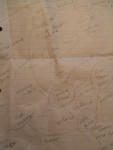Belatedly (I think I might have the dubious honour of being last) I’ve submitted my games for the excellent Sheffield rpg convention, Furnace, which is about 5 weeks away now. It’s all booked up already (and has been for months), so I’m afraid you can’t go even if you want to, but I thought I’d post the games all the same as they’re an insight into the goings on of my gaming world right now. So here they are, with added commentary.
Saturday morning – Lost Days of Memories & Madness
The immortal elves of the Eternal Court are masters of the world, enslaving the lesser races so that their most precious possessesions – their memories – can be harvested for the pleasure of the decadent elven lords. The greatest fear amongst the immortal elves is madness; the greatest taboo is the mention that the stolen memories of others is the path to insanity. When your civilisation is at its peak, the only way is down…
A GMless story game of intrigue and insanity at the end of the world, for 4 players.
Andrew says: you know the drill with this one – it’s a GMless (kinda) game about outscheming all the other players, stealing all their memories and being the last survivor when the world falls apart. All kinds of fun so long as players go for the throat.
Sunday morning – Dead of Night: Salford’s Lot
Salford’s Shadowgate Estate on a friday night, 4 of your best mates, 2 litres of cheap cider and a grimoire full of spells. But tonight there’s trouble brewing – magic that you didn’t call up, monsters that you can’t put down and a real, bonafide witch hunter new in town and with something to prove. Magic – it’ll get you killed. Or worse, grounded.
A horror game in the vein of the Craft, Salem’s Lot and the Covenant, for 5 players.
Andrew says: I’ve wanted to do a Dead of Night scenario with all the players as witches and warlocks for a while now, but as is often the case (and Scott Dorward is like this too, I gather) it’s not until I get a pun-filled name that the brain cells really start rubbing together. Should be fun, in any case, although sunday morning isn’t my preferred horror slot.
Sunday afternoon – Exiles (playtest)
Earth is a distant glimmer in a sea of a thousand stars, and all you’ve got on this alien shore is the close-knit crew you call family and barely enough supplies to last the month. In the face of adversity, can you survive – and more importantly, can your friendships?
A playtest of a game of family in crisis amongst the stars, in the vein of Firefly, Battlestar Galactica, Stargate Universe et al, for 4 players.
This one’s new, and highly subject to change, but I’ve had a yearning to write a game that emulates all those close-knit family-esque sci-fi settings for a while now but – as is often the case – the particulars only unfolded on a recent long drive back from holiday. I’ll post the game itself up later this week.
 Here in England we have a tradition that at Christmas, ghost stories are told and read. I think it dates from the Victorian era, for the Victorians liked a good ghost story, and made the transition to the television in the 70s with an excellent series of ghost stories by the BBC (including Charles Dickens’ The Signalman, pictured). M0re recently, BBC4 has revived the tradition with a mix of fresh adaptations (such as Whistle and I’ll Come to You) and new stories (Mark Gatiss‘ excellent Crooked House).
Here in England we have a tradition that at Christmas, ghost stories are told and read. I think it dates from the Victorian era, for the Victorians liked a good ghost story, and made the transition to the television in the 70s with an excellent series of ghost stories by the BBC (including Charles Dickens’ The Signalman, pictured). M0re recently, BBC4 has revived the tradition with a mix of fresh adaptations (such as Whistle and I’ll Come to You) and new stories (Mark Gatiss‘ excellent Crooked House).